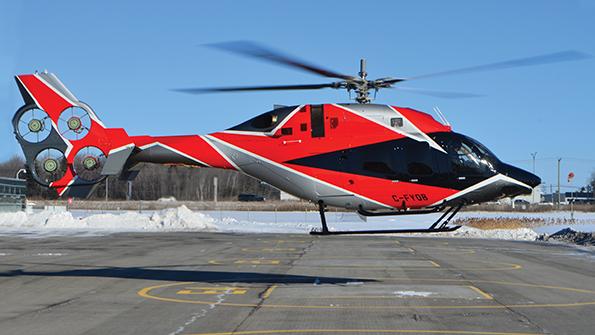
Bell has been quietly flight-testing an electric anti-torque system in a technology demonstration that could be a building block for its work on electric vertical-takeoff-and-landing (eVTOL) mobility systems.
- EDAT demonstrator is modified Bell 429 light twin
- Generator and motors supplied by Safran
The company’s Electrically Distributed Anti-Torque (EDAT) testbed is a highly modified Model 429 twin-engine light helicopter that uses four fixed-pitch electrically driven fans mounted in the vertical stabilizer, replacing the conventional tail rotor.
Although the rotorcraft industry has been exploring the potential of electric anti-torque systems, Bell’s EDAT is the first to make it to flight, with testing beginning in full public gaze—but seemingly unnoticed—last May.
The EDAT only came to light when a video appeared on social media of the testbed hovering near Bell’s Mirabel, Quebec, facility showing the distinctive quad-fan configuration.
The largely self-funded research, which also received financial support in the form of grants provided by the Ottawa government in 2018, is primarily in response to customer calls for greater safety and reduced noise levels, says Eric Sinusas, EDAT program manager and program director for light aircraft.
“Customers have been asking us to do more about safety and the direct operating costs. But in the last few years, noise has become an ever-increasing concern, and that has put pressure on our engineering team,” says Sinusas.
Most helicopter noise is caused by the interaction between the main rotor and the tail rotor, so using ducted anti-torque systems can reduce the noise levels.
Such ducted systems are not new; after all, Airbus’ fenestron dates back to the 1960s. But the use of an electric system means that when the helicopter is not requiring the maximum anti-torque thrust, the rotational speed of the fans can be reduced, lowering tip speeds and noise levels. The company would not reveal specific noise levels with the EDAT, but recorded data “shows that it is significantly quieter than a conventional 429,” Sinusas says.
In terms of safety, conventional tail rotors have always been a hazard, particularly while the aircraft is on the ground with engines running. The EDAT’s anti-torque system, however, can be shut down while the main rotor is still turning. And there may be operating-cost benefits as well: Eliminating complex tail rotor gearboxes and shafts removes the need for inspecting and maintaining them.
But fitment of the EDAT has required significant modifications from nose to tail. Rather than mechanically actuated anti-torque controls, the pedals now provide commands to a fly-by-wire system that controls the output of the four fans. The air-cooled fan motors are powered by a liquid-cooled generator running off the aircraft’s two Pratt & Whitney Canada PW207 turbines. Wires connecting the generator with the motors run down the tail boom, where the tail rotor shaft once sat.
The motors and generators are provided by Safran, which has also worked on the company’s Nexus eVTOL platform.
The fixed-pitch, variable-speed fans are capable of operating in both forward and reverse directions, depending on the pilot’s pedal inputs.
Having four fans also boosts redundancy. Although it has not yet been tested in flight, ground tests have indicated that the pilots would still have some level of anti-torque performance even if three of the four fans were inoperable. Tail rotor failure on a conventional helicopter can be dangerous, if not catastrophic.
Another factor is responsiveness, says Sinusas. “A single large fan or two medium fans are going to experience rotational inertia, so it is going to be less responsive,” he notes, prompting engineers to adopt the quad configuration.
Prior to flight-testing, the company established a systems integration laboratory to test the EDAT before installation, but the team has found it easy to make adjustments to the system once installed on the aircraft.
“We have already had several optimizations and changes, just based on feedback from pilots, and it is much quicker to do than with a mechanical system,” says Sinusas.
Several OEMs have studied the potential of electric anti-torque systems. Leonardo Helicopters tested a modified AW139 tail rotor as part of a research program funded through the European Union’s Clean Sky 1 initiative, and an electric fan-based anti-torque system featured in Bell’s FC-X concept rotorcraft was unveiled in 2017 (AW&ST March 26-April 8, 2018, p. 29).
The next steps will see flight envelope expansion of the EDAT as well as further optimization, particularly in terms of weight.
“We do see it as a steppingstone to the fully electric aircraft,” says Sinusas. “We feel like it should make the certification paths for these technologies easier.”






Comments